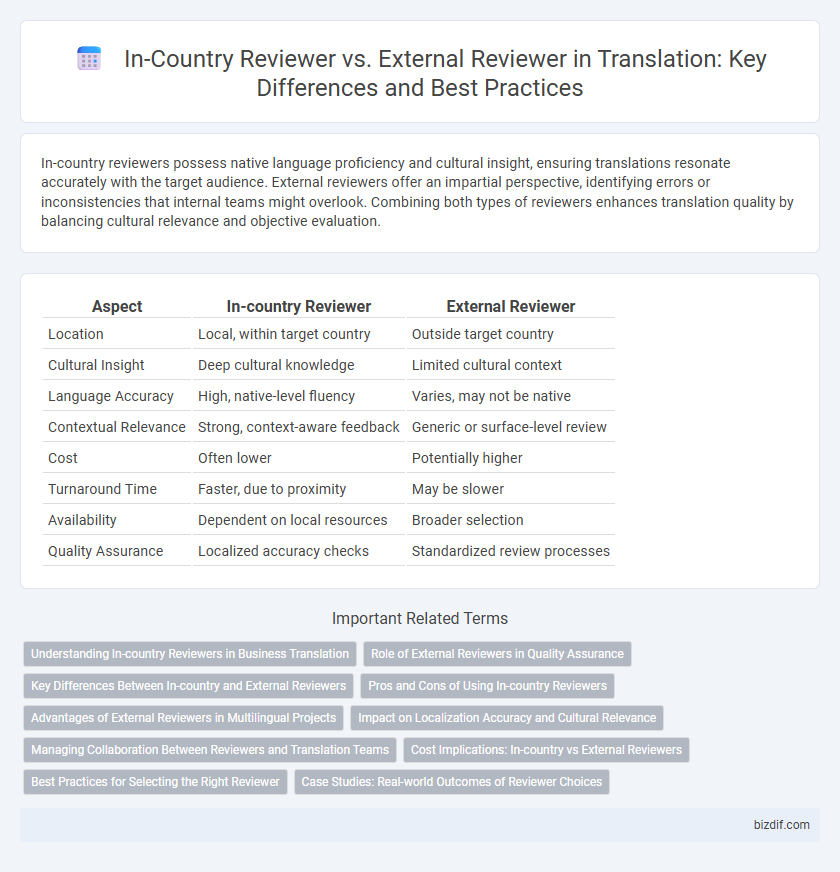In-country reviewers possess native language proficiency and cultural insight, ensuring translations resonate accurately with the target audience. External reviewers offer an impartial perspective, identifying errors or inconsistencies that internal teams might overlook. Combining both types of reviewers enhances translation quality by balancing cultural relevance and objective evaluation.
Table of Comparison
| Aspect | In-country Reviewer | External Reviewer |
|---|---|---|
| Location | Local, within target country | Outside target country |
| Cultural Insight | Deep cultural knowledge | Limited cultural context |
| Language Accuracy | High, native-level fluency | Varies, may not be native |
| Contextual Relevance | Strong, context-aware feedback | Generic or surface-level review |
| Cost | Often lower | Potentially higher |
| Turnaround Time | Faster, due to proximity | May be slower |
| Availability | Dependent on local resources | Broader selection |
| Quality Assurance | Localized accuracy checks | Standardized review processes |
Understanding In-country Reviewers in Business Translation
In-country reviewers possess native-level language proficiency and deep cultural knowledge, making them essential for ensuring translations resonate authentically with the target market. Their expertise in local business practices and regional nuances helps identify context-specific inconsistencies or inaccuracies that external reviewers might overlook. Engaging in-country reviewers enhances the quality, relevance, and credibility of business translations, ultimately fostering stronger connections with local clients and stakeholders.
Role of External Reviewers in Quality Assurance
External reviewers play a critical role in quality assurance by providing an unbiased evaluation of the translated content against source materials, ensuring accuracy and cultural appropriateness. Their expertise in subject matter and linguistic nuances helps identify errors or inconsistencies that in-country reviewers might overlook due to familiarity bias. Incorporating external reviewers enhances the overall reliability and integrity of translation projects, supporting higher client satisfaction and adherence to industry standards.
Key Differences Between In-country and External Reviewers
In-country reviewers possess native linguistic expertise and cultural insight essential for accurate localization, ensuring translations resonate with the target audience's context and nuances. External reviewers, typically specialists from outside the target region, provide objective, high-level accuracy checks and verification, focusing on technical consistency and adherence to project guidelines. While in-country reviewers emphasize cultural relevance, external reviewers prioritize standardized language quality and compliance with industry terminology.
Pros and Cons of Using In-country Reviewers
Using In-country Reviewers ensures culturally accurate translations by leveraging native linguistic nuances and local knowledge, leading to higher authenticity and relevance in the target market. They provide immediate feedback and faster turnaround times due to proximity and familiarity with regional context, reducing misinterpretations and localization errors. However, relying solely on In-country Reviewers may introduce bias or lack exposure to global standards, which can limit the translation's effectiveness in broader markets.
Advantages of External Reviewers in Multilingual Projects
External reviewers bring unbiased perspectives and expert linguistic skills that enhance the overall quality and cultural accuracy of multilingual projects. They provide objective feedback free from internal organizational biases, ensuring translations resonate authentically with target audiences. Utilizing external reviewers often accelerates project timelines by supplementing in-house resources and addressing specialized language nuances effectively.
Impact on Localization Accuracy and Cultural Relevance
In-country reviewers enhance localization accuracy by providing native linguistic validation and cultural insights directly from the target market, ensuring idiomatic expressions and regional nuances are correctly interpreted. External reviewers offer an impartial perspective, identifying potential inconsistencies and errors overlooked by in-country teams, which helps maintain quality control. Combining both reviewer types strengthens overall translation quality, balancing authentic cultural relevance with objective accuracy checks.
Managing Collaboration Between Reviewers and Translation Teams
Managing collaboration between in-country reviewers and external reviewers requires clear communication protocols and defined responsibilities to ensure consistent translation quality. In-country reviewers provide cultural and linguistic accuracy by leveraging native fluency, while external reviewers offer impartial feedback and technical expertise. Coordinating workflows through centralized platforms facilitates real-time feedback, reduces revisions, and aligns all stakeholders on translation project goals.
Cost Implications: In-country vs External Reviewers
In-country reviewers typically offer cost advantages by reducing travel and logistical expenses and leveraging local language and cultural expertise for more accurate translations. External reviewers, often located abroad, may incur higher costs due to international shipping, time zone differences, and added communication layers. Organizations aiming to optimize translation budgets should weigh these cost implications alongside quality and turnaround time to select the most efficient review process.
Best Practices for Selecting the Right Reviewer
Selecting the right reviewer involves evaluating the specific expertise required for the translation project, with in-country reviewers providing culturally nuanced insights and external reviewers offering objective quality checks. Best practices include assessing the reviewer's linguistic proficiency, familiarity with the subject matter, and availability to meet deadlines. Prioritizing reviewers who combine native language skills with domain-specific knowledge ensures accurate and contextually appropriate translations.
Case Studies: Real-world Outcomes of Reviewer Choices
In-country reviewers provide valuable insights grounded in local language nuances and cultural context, enhancing accuracy and relevance in translation projects. External reviewers, often subject matter experts, contribute specialized knowledge and technical precision that may not be available locally. Case studies reveal that combining both reviewer types often leads to superior translation quality and client satisfaction by balancing linguistic authenticity with expert-driven accuracy.
In-country Reviewer vs External Reviewer Infographic

 bizdif.com
bizdif.com